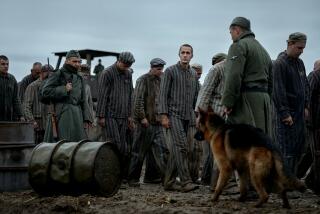On the West Coast front
- Share via
During World War II, Hollywood movies were seen as a powerful propaganda tool -- a role that’s the subject of both a screening sponsored by the Academy of Motion Picture Arts and Sciences and an exhibit at USC’s Fisher Gallery.
The motion picture academy will be screening a program of rare animated films from World War II tonight at the Samuel Goldwyn Theater. Introduced by animation film historian Jerry Beck, the program includes the 60th anniversary presentation of Walt Disney’s animated-live action film “Victory Through Air Power,” based on the book by aviation pioneer Alexander de Seversky.
And in the Quinn Wing of the USC Fisher Gallery is “Warners’ War: Politics, Pop Culture and Propaganda in Wartime Hollywood,” through Dec. 13. The 75-piece exhibition looks at how Jack and Harry Warner of Warner Bros. renown were embroiled in a propaganda war against Hitler long before the United States entered the global conflict in 1941.
The impetus for the academy screening was the recent restoration by Disney of 32 short subjects produced by the studio during World War II, including training, propaganda and education films set for release in December on DVD, noted academy program coordinator Randy Haberkamp. Among the other animated shorts being screened are the Oscar-nominated “Blitz Wolf” (1942) produced by MGM, Warner Bros.’ “Russian Rhapsody” (1943), Columbia’s “Song of Victory” (1943), and Disney’s “Reason & Emotion” (1943) and “Out of the Frying Pan Into the Firing Line” (1942).
Most of these films have not been screened since they were first released; “Victory Through Air Power” was last seen 20 years ago at the Los Angeles County Museum of Art. Though these films rallied Americans behind the war, most of them now would be considered offensive because they portray the Germans and Japanese in racist stereotypes.
Still, says Haberkamp, “I think it’s somewhat dangerous for us to reinvent our history and not face up to what was going on. Those who ignore history are condemned to repeat it. Also, these films were successful in their mission. Obviously, there are some negative aspects. When you are fighting a war, it’s never pretty, and that’s important to remember as you try to avoid it.”
Beck says “Victory Through Air Power” is unlike anything done by Disney before or after. “It’s about a specific moment in time,” he says. “We didn’t have an Air Force at that time, and the thinking at the time was not progressive as far as how we fight wars.”
The 65-minute film looks at the history of aviation through animation and features De Seversky lecturing. The film and the book did turn thinking around. “Walt Disney felt it was his greatest contribution to the war effort,” says Dave Bossert, who produced the upcoming Disney DVD “On the Front Lines.”
The USC exhibition is culled from the USC Warner Bros. Archives and features film stills, historical documents, animation art, press books, interoffice memos and selected shorts.
“The set drawings are really the highlight,” says Randi Hokett, curator of the exhibition and director of the archives. “They are caricatures of Hitler and Mussolini and are very strong. They are from one of the military shorts.”
In retrospect, says Hokett, the Warner brothers had the foresight to realize the world was in peril as soon as Hitler took reign of Germany in 1933. “All of the film companies were present in Europe; they saw pretty early on what was going on there and they were concerned. Jack Warner tells this story in his autobiography that in ’33 or ‘34, they had a man in Germany running their German operations and he was beaten to death because he was a Jew. Jack Warner was a storyteller and it’s hard to say whether or not there is any truth to it, but by ’34 Harry Warner decided to pull out of Germany.”
The Warner brothers, like the majority of the Hollywood studio moguls, were European Jews. “They felt they were lucky enough to be in a position of having a certain amount of power and having beliefs that we shouldn’t ignore the situation,” Hokett says.
Though the Warners said that their “patriotic” productions, such as 1941’s “Sergeant York,” were purely for entertainment, they ran into trouble with the government in 1941. “The Senate established a subcommittee started by two isolationist senators and held hearings,” says Hokett. “They were accusing Hollywood and accusing the Warner brothers of being the ringleaders of warmongering.”
The bombing of Pearl Harbor on Dec. 7, 1941, effectively ended the hearings and by the following year, President Franklin D. Roosevelt’s administration and the Warner brothers were able to collaborate on wartime propaganda. Jack Warner was commissioned as a lieutenant colonel in the Army Air Forces and began the First Motion Picture Unit, which made training films and documentaries.
On Oct. 28 at 8 p.m., “Confessions of a Nazi Spy” will be screened for free at USC’s Lucas 108, and Oct. 30 at 4 p.m. a panel will discuss “Propaganda, Pop Culture and Public Diplomacy” at Annenberg Auditorium.
*
World War II Hollywood
What: “Victory Through Air Power”
Where: Samuel Goldwyn Theater, Academy of Motion Picture Arts and Sciences, 8949 Wilshire Blvd., Beverly Hills
When: Tonight, 8
Price: $5 for public; $3 for academy members and students with valid I.D.
Contact: (310) 247-3600
Also
What: “Warner’s War”
Where: USC’s Fisher Gallery, Los Angeles
When: Tuesdays through Saturday, noon to 5 p.m.
Ends: Dec. 13
Price: Free
More to Read
The biggest entertainment stories
Get our big stories about Hollywood, film, television, music, arts, culture and more right in your inbox as soon as they publish.
You may occasionally receive promotional content from the Los Angeles Times.











